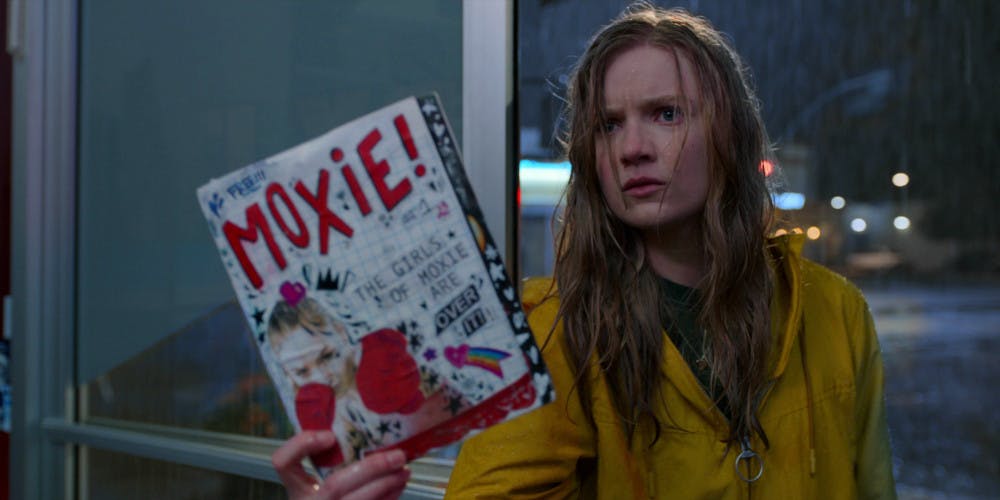Earnest but often unrealistic, Amy Poehler’s “Moxie” misses the mark on its attempt to communicate revolutionary feminism within a modern high school.
Based on the young adult novel by Jennifer Matheiu, the recent Netflix original film “Moxie,” released March 3, tells the story of Vivian (Hadley Robinson), an introverted high school junior who becomes inspired by new classmates to become the anonymous leader of a feminist movement. Vivian’s newfound feminism is also motivated by her mother, Lisa (Amy Poehler), who has a political past as a passionate feminist in the Riot grrrl movement of the early ‘90s.
Multiple factors contribute to Vivian’s decision to create a zine that brings attention to the sexist culture at her high school: admiration of a fearless new student, Lucy (Alycia Pascual-Peña), an oddly fitting college application question asking her to “reflect on a cause you feel passionate about” and frustration with the passivity of female students to act against male students’ flagrant sexism.
What truly sparks Vivian’s desire for revolution is the vulgar list constructed by the football team, namely captain Mitchell Wilson (Patrick Schwarzenegger), in which Vivian is coined “Most Obedient.” Not willing to occupy that role, and fueled by other female students’ discomfort with the list and blatant disregard from the administration, Vivian begins to produce zines entitled “Moxie” detailing the frustrations of existing in a sexist environment along with the names of some sexist perpetrators. Infused with newfound passion, inspired by her mother’s zine collection and armed with “Moxie,” Vivian becomes an anonymous feminist hero intent on exposing the misogynistic environment that characterizes her high school.
The film taps into a nostalgia for the girl power of the 1990s. Vivian discovers her mother’s treasure chest of buttons, stickers and zines from her own days as part of the Riot grrrl movement. This nostalgia is expressed not only through the contents of Lisa’s suitcase, but also through more nuanced elements throughout the film, like when Lisa wears a Sleater-Kinney t-shirt and when Bikini Kill’s “Rebel Girl,” the movie’s theme song, plays.
Vivian’s zine is a refreshing take on the use of media by high school girls in an age where digital media like Instagram and TikTok dominate. The drawings and magazine cut-outs that comprise the zine, and the Xeroxing of copies to distribute around the school, are a wonderful reminder of tactile media and a DIY aesthetic that stands in sharp contrast to the curated feminism of social media.
But social media still plays a role in Vivian’s movement, as Instagram is used as a tool to expand the audience beyond readers of the handmade zines. The use of “old” media and digital media together allow for a movement to be forged at the high school through symbols (stars and hearts written on hands), walk-outs in objection to sexist dress codes and emotional protests over sexual violence.
The film’s cast had many standouts and was filled with diverse, young actors who provided an admirable range of representation for viewers. Through its cast diversity, the film addresses the exclusion of women of color that problematized the original Riot grrrl movement. The film tells a heartwarming story of empowerment, and the love story between sensitive skater Seth (Nico Hiraga) and Vivian keeps viewers rooting for the central characters.
However, the film fails in focusing on a single message, which lends to its social critiques feeling underdeveloped. “Moxie” attempts to tackle a plethora of issues, including pressures within immigrant families, gender inequalities within sports and other overarching prejudices around gender and sexuality. In attempting to address this broad swath of social issues, the passion behind the main obstacle that Moxie is aiming to tackle — that of gender inequality within Rockport High School — is weakened.
In addition, the framing of revolution in “Moxie” as attainable through stickers and zines left on top of hand dryers in the school bathroom feels starry-eyed. This glossy vision of revolution oversimplifies the struggles that come with bringing about change. Despite its moments of empowerment, “Moxie” fails to represent the complexity of struggles that characterize feminism.
For example, when Vivian’s bookish, childhood best friend Claudia (Lauren Tsai) reveals the slightest hesitation to join the “Moxie” movement, which stems from her desire to appease the expectations of her mother, she is completely shut out. There is a trendiness to the feminism depicted in the movie, one that dilutes a long history of feminism as a branch of intersectional politics.
And, despite having a very diverse cast with characters of different races, genders and sexualities, the film focuses on Vivian, who is a cisgender, heterosexual, white woman. Even when the other characters experience discrimination — like Kiera (Sydney Park) losing a scholarship to Mitchell, or Claudia’s fear of letting down her mother — the film still tells those struggles through Vivian’s perspective. In this one-sidedness, the film falls flat on intersectionality, despite the potential brought by such a diverse cast.
Ultimately, “Moxie” delivers an uplifting message: Empower women and fight against everyday sexism and misogyny. The cast was fresh, the punky soundtrack was exciting and the story was definitely entertaining.
But, the film does not always deliver with clarity its feminist message, which is undeniably its most important aspect. In “Moxie,” the grittiness and productive rage that fueled the Riot grrrl movement of the 90s is nostalgically reimagined in the current moment. But, like the original, this glossy reimagination oversimplifies the feminist mission and fails to adopt intersectional perspectives.

ADVERTISEMENT




